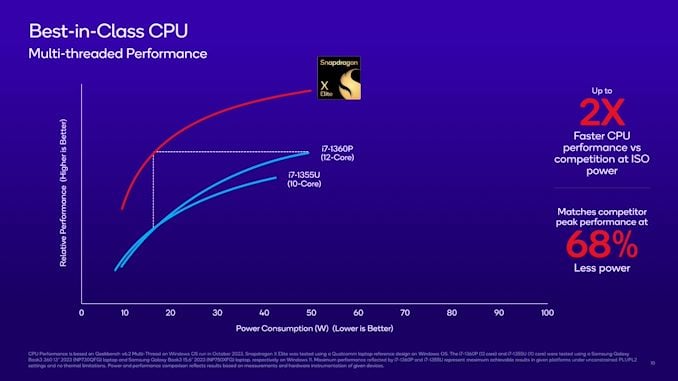Qualcomm has shown off some impressive numbers showcasing the capabilities of its upcoming Snapdragon X Elite chip. The benchmark results Qualcomm revealed to the press hint that the upcoming Windows-on-Arm laptops powered by the Snapdragon X Elite chip will outcompete both Intel processors and Apple’s M series chips.

No details were shared about how they performed the tests, and the comparison charts were unverified
However, the company never provided much details about which setup tested the Snapdragon X Elite chip. “Qualcomm has been far from forthcoming with its curated benchmark results that have been presented to the press,” claims a recent report from SemiAccurate. “Qualcomm benchmarks are impossible to recreate even by class-leading OEM developers.” The charts comparing the performance with its competitors’ offerings were also unverified.
Later on, when device manufacturers got their hands on the new X series chip, they could not even get close to the numbers that Qualcomm showed off to the press. According to SemiAccurate, OEMs first saw numbers not even reaching 50% of the claims. In response to the disparity, Qualcomm engineers blamed poor optimization of Windows-on-Arm and poor cooling of the devices. OEMs couldn’t improve the results much even after working on the cooling solution. A source (anonymous) even compared the Snapdragon X Elite to Intel Celeron chips. For those unfamiliar, these are Intel’s entry-level chips with low power requirements.
Nonetheless, if the X Elite chips are going to be mounted on devices made by the same OEMs that are testing the chips and are going to run Windows, it shouldn’t matter how Qualcomm tested the new Snapdragon X Elite.
The company also avoided answering more technical questions about its upcoming Snapdragon X series. They promised deep technical briefings before the launch, which is scheduled to be somewhere around “mid-2024”.
Qualcomm has also revealed the Snapdragon X Plus, a cut-down and more affordable version of the previously announced Snapdragon X Elite chip. The announcement also reportedly lacked the deep technical elements originally promised, with more time spent on potential camera specs enabled by the SoC than any real technical stats or deep analysis.
Related:
- Get $100 OFF on Xiaomi 14 Pro at Giztop (1TB Variant)
- Lenovo Legion Y700 2024: Latest Gaming Tablet with Enhanced Display now available at Giztop
- REDMAGIC Magnetic VC Cooler 5 Pro now available at a discounted price at GeekWills
- HyperOS Update Is Available for These Xiaomi, Redmi, and Poco Devices in India







